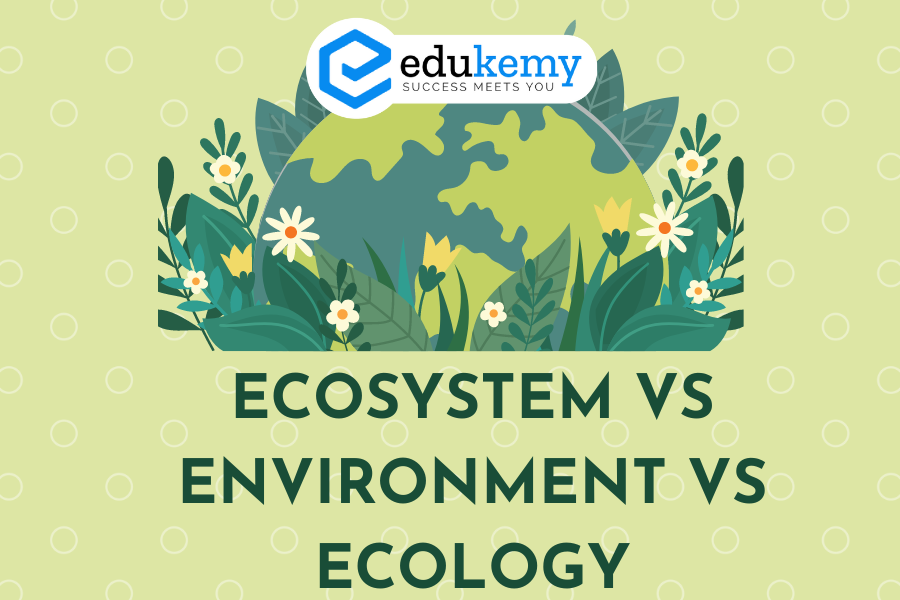- Ecology and ecosystem are frequently employed terms to elucidate the interactions between organisms and their environment.
- Ecology delves into the exploration of the relationships and interactions among living organisms and their surroundings.
- On the other hand, the term ecosystem represents a specific domain within the realm of ecology.
- It encompasses biotic factors, encompassing animals, plants, and microorganisms, alongside abiotic factors, which comprise all non-living physical elements in the environment.
- While ecology focuses on the comprehensive study of ecosystems, these ecosystems emerge as entities formed by the interplay between a community of organisms and their environmental context.
Contents
- 1 ECOLOGY
- 2 Frequently Asked Questions (FAQs) on Ecology and Ecosystems:
- 2.1 1. What is the distinction between ecology and ecosystems?
- 2.2 2. How does ecology contribute to our understanding of living organisms?
- 2.3 3. What are the categories of organisms based on nutrition in ecology?
- 2.4 4. How do ecologists categorize organisms based on habitat types?
- 2.5 5. What defines an ecosystem?
- 2.6 6. How are food chains and food webs significant in ecosystems?
- 2.7 7. What are the primary components of ecosystems?
- 2.8 8. How does energy flow within ecosystems?
- 3 In case you still have your doubts, contact us on 9811333901.
ECOLOGY
- Ecology is an extensive field of study that encompasses the entirety of ecosystems. Biologists within this discipline delve into the examination of various relationships existing among living species.
- These relationships encompass both intra-connections among living creatures and inter-connections between living and non-living elements.
- As a result, ecology incorporates three fundamental components, namely living organisms, interactions between organisms, and relationships between organisms and their environment.
- Within the realm of ecology, the study extends to elucidating the physiological, genetic, behavioral, and dietary patterns of organisms.
- Additionally, nutrition plays a significant role in ecology, leading to the classification of organisms into categories such as symbionts, saprophytes, parasites, predators, and others. The study of ecology further involves categorization based on the type of habitat under investigation.
- Ecologists classify organisms and their interactions by considering environmental factors like temperature, soil type, water availability, humidity, and rainfall.
What Constitutes an Ecosystem?
- Ecosystems, a subset within the field of ecology, encompass the entirety of both biotic and abiotic elements within a community.
- Biotic components include all living organisms present in the community, representing a diverse array of life.
- Abiotic components comprise non-living elements such as sunlight, water, minerals, and the prevailing climate, shaping the physical environment.
- The intricate connection between living and nonliving components is established through the flow of energy and the nutritional requirements of organisms.
- Food chains serve as a pivotal aspect of ecosystems, illustrating the dynamic flow of energy and nutritional dependencies among species.
- These chains typically initiate with autotrophic primary producers, exemplified by green plants that harness sunlight as their primary energy source for food production.
- Consumers, including herbivores, omnivores, and carnivores, fulfill their nutritional and energy needs as they progress through the food chain.
- Interconnections between various food chains give rise to food webs, complex networks that elucidate the relationships among different species within the ecosystem.
Frequently Asked Questions (FAQs) on Ecology and Ecosystems:
1. What is the distinction between ecology and ecosystems?
A: Ecology is the broader study of the relationships and interactions among living organisms and their environment. Ecosystems, on the other hand, represent specific domains within ecology, comprising both living (biotic) and non-living (abiotic) elements in a defined area.
2. How does ecology contribute to our understanding of living organisms?
A: Ecology, as a scientific field, investigates various aspects of living organisms, including their physiological, genetic, behavioral, and dietary patterns. It explores intra-connections among organisms and inter-connections between living and non-living elements.
3. What are the categories of organisms based on nutrition in ecology?
A: Nutrition in ecology leads to the classification of organisms into categories such as symbionts, saprophytes, parasites, predators, and more, reflecting their roles and relationships within ecosystems.
4. How do ecologists categorize organisms based on habitat types?
A: Ecologists classify organisms based on environmental factors like temperature, soil type, water availability, humidity, and rainfall. This categorization provides insights into how organisms adapt to and interact within specific habitats.
5. What defines an ecosystem?
A: Ecosystems encompass both living (biotic) and non-living (abiotic) components within a community. This includes all organisms present, such as animals, plants, and microorganisms, as well as non-living elements like sunlight, water, minerals, and climate. The interplay between these components forms the basis of an ecosystem.
6. How are food chains and food webs significant in ecosystems?
A: Food chains illustrate the dynamic flow of energy and nutritional dependencies among species in an ecosystem. Autotrophic primary producers, like green plants, initiate these chains by harnessing sunlight for food production. Food webs represent interconnected networks of various food chains, showcasing the relationships among different species.
7. What are the primary components of ecosystems?
A: The primary components of ecosystems are biotic, including all living organisms, and abiotic, encompassing non-living elements such as sunlight, water, minerals, and climate. The interconnection between these components is vital for the functioning of ecosystems.
8. How does energy flow within ecosystems?
A: Energy in ecosystems flows through food chains, starting with autotrophic primary producers that convert sunlight into food. Consumers, including herbivores, omnivores, and carnivores, fulfill their energy needs by consuming other organisms, creating a dynamic flow of energy within the ecosystem.
In case you still have your doubts, contact us on 9811333901.
For UPSC Prelims Resources, Click here
For Daily Updates and Study Material:
Join our Telegram Channel – Edukemy for IAS
- 1. Learn through Videos – here
- 2. Be Exam Ready by Practicing Daily MCQs – here
- 3. Daily Newsletter – Get all your Current Affairs Covered – here
- 4. Mains Answer Writing Practice – here

